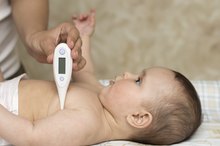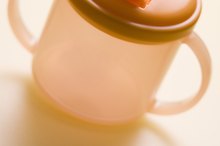Dark Yellow Urine While Breastfeeding
Dark yellow urine while breast-feeding is a concern whether it's you or your baby that's experiencing this symptom. Dark yellow urine can indicate a need to drink more fluids, but could also indicate more serious disorders. If you or your baby have dark urine and you feel like you're drinking enough fluid, call your baby's doctor.
If you are experiencing serious medical symptoms, seek emergency treatment immediately.
Dark Yellow Urine and Mom
If you notice your urine becoming darker, you might not have had enough to drink. Breast-feeding moms need around 13 cups of water or other fluids, according to the American Dietetic Association 1. It's easy to forget to drink enough, especially when your baby first comes home from the hospital. Make it a habit to pour yourself a tell drink of water, juice or other liquid whenever you sit down to breast-feed. If you don't drink enough, you could become dehydrated and your milk supply could suffer. If you're drinking an adequate amount but still have dark urine, call your doctor.
- If you notice your urine becoming darker, you might not have had enough to drink.
- If you're drinking an adequate amount but still have dark urine, call your doctor.
Infant Dehydration
When Does a Fever Become Dangerous for a Baby?
Learn More
If your baby produces dark yellow urine, she could be dehydrated. Dehydration can occur if a baby loses extra fluid from vomiting, diarrhea or fever 4. If your baby doesn't have any of those problems, she might not be getting enough breast milk. Your baby's doctor might want to do a weight check to ensure she's getting enough breast milk to grow properly. Other signs of possible dehydration in a baby include dry lips, decreased urination, strong-smelling urine, sunken eyes, lethargy, a weak cry or a sunken soft spot on the top of her head 4.
Neonatal Jaundice
In some cases, dark yellow urine could indicate neonatal jaundice. Neonatal jaundice is common, affecting up to 60 percent of term infants in the first week, Dr. Meredith Porter reports in the February 2002 issue of "American Family Physician." Other symptoms can accompany dark urine in neonatal jaundice; your baby's skin and the whites of her eyes could appear yellow from high bilirubin levels and she might be lethargic. Breast-feeding jaundice occurs separately from normal, or physiological newborn, jaundice. Breast-feeding jaundice can develop up to two weeks after birth. Up to 33 percent of healthy breast-fed babies can develop breast-feeding jaundice, according to Porter. Follow your pediatrician's instructions on treating breast-feeding jaundice. In rare cases, jaundice could indicate liver problems or infection in an infant.
- In some cases, dark yellow urine could indicate neonatal jaundice.
- Other symptoms can accompany dark urine in neonatal jaundice; your baby's skin and the whites of her eyes could appear yellow from high bilirubin levels and she might be lethargic.
Treating Dark Urine
Fever at Night in Infants & Toddlers
Learn More
If your urine is dark because you haven't been drinking enough, upping your fluid intake should solve the problem. If low milk supply causes decreases urine output or dehydration in your baby, work with a lactation consultant on increasing your milk supply 4. Start supplemental feedings if your doctor or lactation consultant feel it's necessary. If your baby has jaundice, she might need to spend time under special phototherapy lights that break down bilirubin. The bilirubin is then excreted in the urine, which can also make the urine appear dark.
- If your urine is dark because you haven't been drinking enough, upping your fluid intake should solve the problem.
Related Articles
References
- American Family Physician: Hyperbilirubinemia
- BabyCenter: Dehydration
- Bilirubin Blood Test. US National Library of Medicine. 2019.
- Jaundice. US National Library of Medicine. March 2019.
- Chen HL, Wu SH, Hsu SH, Liou BY, Chen HL, Chang MH. Jaundice revisited: recent advances in the diagnosis and treatment of inherited cholestatic liver diseases. J Biomed Sci. 2018;25(1):75. doi:10.1186/s12929-018-0475-8
- Liver function test. US National Library of Medicine. September 2019.
- Hepatitis Panel. US National Library of Medicine. October 2019.
- Ziessman HA. Hepatobiliary scintigraphy in 2014. J Nucl Med Technol. 2014;42(4):249-59. doi:10.2967/jnumed.113.131490
- Gamersddin M, Abdalgaffar R, Yousef M.The role of ultrasound in diagnosis of obstructive Jaundice causes in Sudanese population. IOSR Journal of Nursing and Health Science. 2013;1(4):25-28. doi:10.9790/1959-0142528
- Herrine SK. Jaundice in Adults. Merck Manual Consumer Version. May 2018.
- Hemolytic Anemia. National Institutes of Health.
- Gallstones. Cleveland Clinic. October 2019.
- Bhutani VK. Filtered sunlight noninferior to conventional phototherapy. J Pediatr. 2016;170:341-2. doi:10.1016/j.jpeds.2015.12.054
- Siddiqui AA. Primary Sclerosing Cholangitis. Merck Manuals Consumer Version. November 2018.
Writer Bio
A registered nurse with more than 25 years of experience in oncology, labor/delivery, neonatal intensive care, infertility and ophthalmology, Sharon Perkins has also coauthored and edited numerous health books for the Wiley "Dummies" series. Perkins also has extensive experience working in home health with medically fragile pediatric patients.









